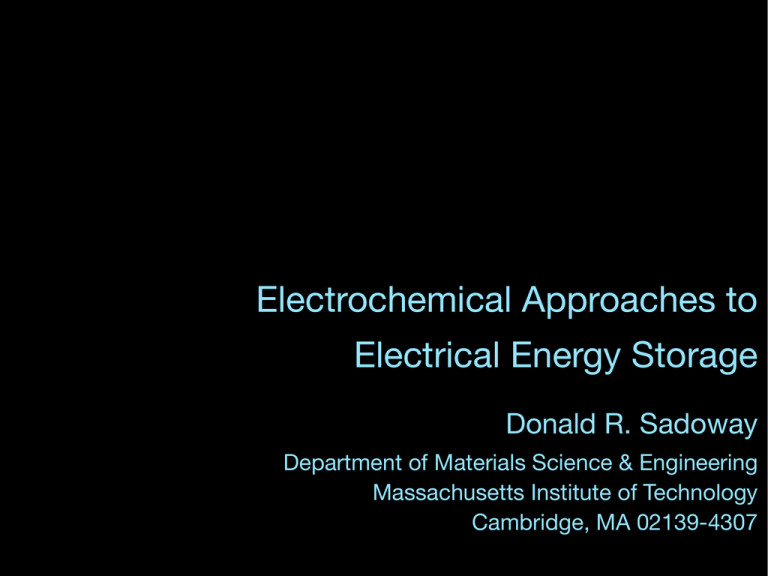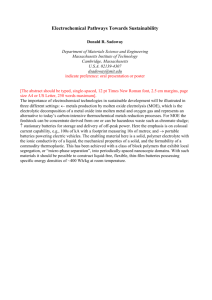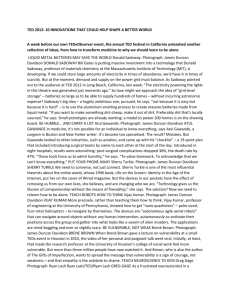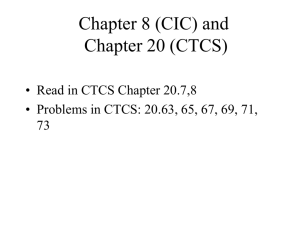Electrochemical Approaches to Electrical Energy Storage Donald R. Sadoway
advertisement

Electrochemical Approaches to Electrical Energy Storage Donald R. Sadoway Department of Materials Science & Engineering Massachusetts Institute of Technology Cambridge, MA 02139-4307 1 outline the energy storage landscape an electrometallurgical approach to large-scale storage portable storage: beyond lithium misconceptions about batteries ๏ not much has changed: not true! electrical energy storage (Wh/kg) (MJ/kg) lead acid 35 0.13 NiCd 45 0.16 NaS 80 0.28 NiMH 90 0.32 Li ion 150 gasoline 12000 0.54 43 misconceptions about batteries ๏ not much has changed: not true! ๏ no Moore’s Law (transistor count 2x every 2 years): the battery is an electrochemical device 2 interfacial reactions, each drawing upon reagents transported from contiguous volumes mass and charge transport required ๏ all microelectronics are silicon-based: device performance improvements come from better manufacturing capabilities ๏ all new batteries are based on entirely new chemistries radical innovation different approaches for different applications ๏ don’t pay for attributes you don’t need ๏ cell phone needs to be idiot-proof ๏ car needs to be crashworthy ๏ safety is a premium in both applications ๏ how about service temperature? human contact? ๏ stationary batteries: more freedom in choice of chemistry but very low price point market price points application price point laptop computer $2,000 - $3,000 / kWh communications $1,000 / kWh automobile traction $100 - 200 / kWh stationary storage $50 / kWh severity of service conditions price storage is the key enabler ๏ for deployment of renewables: unless their intermittency can be addressed they cannot contribute to baseload even if you had 100% conversion efficiency in photovoltaics they still wouldn’t make it in much of the marketplace ๏ in grid-level storage we need to think about the problem differently when combustion is an option: batteries invented for portable applications are not scalable at an acceptable price point stringing together thousands of Li-ion batteries won’t do: here the whole is less than the sum of its parts storage is the key enabler ๏ smart grid requires rapid response capability colossal electric cache August 13, 2003 9:21 p.m. EDT August 14, 2003 9:03 p.m. EDT Images by NOAA/DMSP. 10 storage is the key enabler ๏ smart grid requires rapid response capability colossal electric cache ๏ transmission line congestion colossal electric cache ๏ load leveling colossal electric cache ๏ load following colossal electric cache accelerating the rate of discovery ๏ there is plenty of room at the top: we are not up against any natural laws of nature yet time to start thinking beyond lithium ๏ the field is woefully underfunded by government: energy research in total $1.4B (2006) < ⅙ 1979 figure c.f. medical research rose by 4× to $29B ๏ the private sector research spending is even bleaker: US energy industry < 0.25% revenues c.f. pharmaceuticals 18% semiconductors 16% automotive 3% accelerating the rate of discovery ๏ more money more people sustained effort the brightest minds ๏ new approaches: computational materials science Volta partners with Schrödinger, i.e., bring quantum mechanics to battery engineering high-throughput computing screens candidate materials before lab testing begins ๏ confine chemistry to earth-abundant elements readily available, i.e., not to those potentially subject to cartel pricing how to think about inventing in this space ๏ look at the economy of scale of modern electrometallurgy: aluminium smelter ๏ bauxite, cryolite, petroleum coke, capital cost of $5000/annual tonne, 14 kWh/kg virgin metal for less than $1.00/kg ๏ how is this possible? we don’t make aluminium in little beakers ๏ to make metal by the tonne we have giant cells, literally large halls in which liquid metal pools on a single cathode spread over the entire floor a modern aluminium smelter 1886 Charles Martin Hall, USA Paul L.T. Héroult, France 15 m × 3 m × 1 km × 0.8 A⋅cm−2 15 16 17 18 how to think about inventing in this space: pose the right question start with a giant current sink convert this… …into this Heavy Duty Batter y aluminium potline 350,000 A, 4 V Image by MIT OpenCourseWare. Adapted from Donald Sadoway. The result of work started 3 years ago under sponsorship by the MIT Deshpande Center and the Chesonis Family Foundation: reversible ambipolar electrolysis, a.k.a., liquid metal battery Molten Magnesium Electrolyte Refractory lining Molten Antimony Image by MIT OpenCourseWare. on discharge Mg(liquid) 2 + Mg Sb(liquid) + 3 liquid metal battery e- + 2 - e 3 Sb Molten Magnesium Electrolyte Refractory lining refra Molten Antimony Image by MIT OpenCourseWare. 21 cell section after cycling 48 h at 700°C electropositive anode molten salt electrolyte electronegative cathode 22 attributes of all-liquid battery all-liquid construction eliminates reliance on solid-state diffusion long service life liquid-liquid interfaces are kinetically the fastest in all of electrochemistry low activation overvoltage 23 attributes of all-liquid battery all-liquid construction eliminates any reliance on solid-state diffusion long service life liquid-liquid interfaces are kinetically the fastest in all of electrochemistry low activation overvoltage all-liquid configuration is self-assembling expected to be scalable at low cost 24 H Li Rejection criteria Candidate electrode metals Negative electrode Radioactive, rare, toxic, sublimates Positive electrode Be He Non-metal Expensive (> $ 400 / kg) o High melting point (> 1000 C) B C N O F Ne Al Si P S Cl Ar Multiple oxidation states Na Mg K Ca Sc Ti V Cr Mn Fe Co Ni Cu Zn Ga Ge As Se Br Kr Rb Sr Y Zr Nb Mo Tc Ru Rh Pd Ag Cd In Sn Sb Te I Xe Cs Ba La Hr Ta W Re Os Ir Pt Au Hg Tl Pb Bi Po At Rn Fr Ra Ac Ce Pr Nd Pm Sm Eu Gd Tb Dy Ho Er Tm Yb Lu Th Pa U Np Pu Am Cm Bk Cf Es Fm Md No Lr Image by MIT OpenCourseWare. 25 cost / performance better than lithium-ion, cheaper than lead acid ??? Liquid Metal Battery 27 opportunities for basic science database is spotty: alloys lacking widespread commercial use theory not ready to predict properties of liquid metals and alloys properties must be measured emf data in molten salts require verification with candidate metal couples “доверяй, но проверяй” ...trust, but verify... 28 activity measurements of Ca - Bi alloys scaling laws: towards self-heating cell 32 33 next steps cycle performance data analysis of failure modes self heating cell cell optimization cost model 34 tethered in the wireless age portable power enabling radical innovation: biomedical devices transportation Images of an implantable defibrillator and an electric car have been removed due to copyright restrictions. Sadoway 10.391J Sustainable Energy November 23, 2010 motivation Imagine driving this: Sadoway 10.391J Sustainable Energy November 23, 2010 motivation (continued) without the need for this: Image by Mirjana Chamberlain-Vucic on Flickr. Sadoway 10.391J Sustainable Energy November 23, 2010 relevant enabling technology Heavy Duty Batter y Image by MIT OpenCourseWare. Adapted from Donald Sadoway. Sadoway 10.391J Sustainable Energy November 23, 2010 The message There’s plenty of room at the top: we are far from hitting the ceiling set by nature. The road to success is paved with advanced materials. Sadoway 10.391J Sustainable Energy November 23, 2010 A bit of automotive history 1888 Frederick Kimball, Boston: first electric passenger car why now the renewed interest? answer: CARB to improve urban air quality CARB set new standards, including... CARB Implementation Dates for ZEVs 1998 2% new car sales 2001 5% new car sales 2003 10% new car sales 1991 NESCAUM formed 1992 MA adopts CA standards in the minds of many policy makers, ZEV implies EV Sadoway 10.391J Sustainable Energy November 23, 2010 Problems with EV propulsion 1. range: function of energy density of the battery. Compare gasoline @ 13,000 (theo.) / 2600 Wh/kg with the lead-acid battery @ 175 (theo.) / 35 Wh/kg 2. time to refuel: charge 40 kWh in 5 minutes? 220 V × 2200 A!!! When you pump gasoline @ 20 /min, your energy transfer rate is about 10 MW! (Hint: energy density of gasoline is 10 kWhth/.) Sadoway 10.391J Sustainable Energy November 23, 2010 Problems with EV propulsion 3. cost: (1) light but safe means higher materials costs, e.g., less steel, more aluminum; and higher processing costs, e.g., fewer castings, more forgings... (2) to reduce load on the battery requires high efficiency appliances costly (3) low cycle life — batteries priced @ $4,000 to $8,000 lasting about 2 years Sadoway 10.391J Sustainable Energy November 23, 2010 Battery basics what is a battery? a device for exploiting chemical energy to perform electrical work i.e., an electrochemical power source the design paradigm? choose a chemical reaction with a large driving force (ΔG) and fast kinetics to cause the reaction to occur by steps involving electron transfer Sadoway 10.391J Sustainable Energy November 23, 2010 A simple chemical reaction PbO2 + Pb + H2SO4(aq) 2 H2O + PbSO4 intimate mixing of all reactants Sadoway 10.391J Sustainable Energy November 23, 2010 Same reaction, but not so simple Pb + SO42−(aq) PbSO4 + 2 e− PbO2 + 4 H+(aq) + SO42−(aq) + 2 e− 2 H2O + PbSO4 reactants physically separated Sadoway 10.391J Sustainable Energy November 23, 2010 Electrons in motion Pb + SO42−(aq) PbSO4 + 2 e− PbO2 + 4 H+(aq) + SO42−(aq) + 2 e− 2 H2O + PbSO4 Sadoway 10.391J Sustainable Energy November 23, 2010 Electrons in motion PbSO4 + 2 e− Pb + SO42−(aq) 2 H2O + PbSO4 PbO2 + 4 H+(aq) + SO42−(aq) + 2 e− Sadoway 10.391J Sustainable Energy November 23, 2010 The lead-acid battery anode: Pb + SO42−(aq) 0 Pb 2+ Pb PbSO4 + 2 e− + n (oxid ) 2e− cathode: PbO2 + 4 H+(aq) + SO42−(aq) + 2 e− 2 H2O + PbSO4 4+ Pb Sadoway + 2 e− 10.391J Sustainable Energy 2+ Pb n (red ) November 23, 2010 Lead-acid battery on discharge Image by MIT OpenCourseWare. Adapted from Donald Sadoway. Sadoway 10.391J Sustainable Energy November 23, 2010 The nickel metal-hydride battery cathode: NiOOH(aq) + 2 H2O + e− Ni(OH)2(aq) + OH−(aq) anode: MH + OH−(aq) M + H2O + e− electrolyte: 30% KOH(aq) (alkaline) Sadoway 10.391J Sustainable Energy November 23, 2010 The nickel metal-hydride battery cathode: NiOOH(aq) + 2 H2O + e− Ni(OH)2(aq) + OH−(aq) 3+ Ni + e− 2+ Ni anode: MH + OH−(aq) M + H2O + e− H Sadoway + H + e− 10.391J Sustainable Energy November 23, 2010 The lithium ion battery anode (-) Liin carbon + Li + e cathode (+) + Li + Li + e + e + LixCoO2 Li1+xCoO2 + 4+ Co + Li + 3+ Co electrolyte: 1 M LiPF6 in 1:1 ethylene carbonate – propylene carbonate Sadoway 10.391J Sustainable Energy November 23, 2010 Battery Performance Metrics [1] J.-M. Tarascon and M. Armand, Nature 414, 359 - 367 (2001) Reprinted by permission from Macmillan Publishers Ltd: Nature. Sadoway Ragone plot Source: Tarascon, J. M., and M. Armand. "Issues and Challenges Facing Rechargeable Lithium Batteries." Nature 414 (2001). © 2001. 10.391J Sustainable Energy November 23, 2010 Warhol, “Marilyn Diptych” (1962) Tate Gallery Please see Andy Warhol, "Marilyn Diptych," 1962. Sadoway 10.391J Sustainable Energy November 23, 2010 Sadoway, “GM EV1 Diptych” (2005) Private Collection 1 Wh/kg storage capacity 1 mile driving range Sadoway 10.391J Sustainable Energy November 23, 2010 USABC Long-term Performance Goals operating temp. -40 to 85ºC specific energy 200 Wh/kg @ C/3 energy density 300 Wh/L @ C/3 specific power 400 W/kg power density 600 W/L cycle life 1000 cycles @ 80% DOD service life 10 years ultimate price ~ $100/kWh for 40 kWh packs Sadoway 10.391J Sustainable Energy November 23, 2010 new thresholds in performance Today LiCoO2, LiNiO2, LiFe(PO4) all use only one electron per metal (e.g. Co4+/Co3+) 47.88 22 50.9415 Ti Titanium 23 V Vanadium 51.9961 24 Cr Chromium 54.93805 25 55.847 Mn Manganese 26 58.93320 Fe Iron 27 58.6934 Co Cobalt 28 Ni Nickel Image by MIT OpenCourseWare. ⇒ theoretical capacity limited << 300 mAh/g The Future compounds where metal cycles over multiple redox steps Sadoway 10.391J Sustainable Energy November 23, 2010 breaking the one-electron barrier In the presence of Mn, + Li 2e + + LiXNiO2 Li1+XNiO2 Li+ + 2e- + Ni4+ Li+ + Ni2+ theoretical capacity G. Ceder, MIT ≈ 600 mAh/g ! ≈ 540 Wh/kg ! c.f. 150 Wh/kg in Li ion two-electron change around Ni upon Li intercalation Courtesy of Gerbrand Ceder. Used with permission. Sadoway 10.391J Sustainable Energy November 23, 2010 breaking the one-electron barrier Your wildest dream Li+ + 3e- + LiXCrO3 Li1+XCrO3 + Li + 3e + 6+ Cr + Li + 3+ Cr theoretical capacity ≈ 1000 mAh/g ! ≈ 700 Wh/kg ! 700 mi Sadoway 10.391J Sustainable Energy November 23, 2010 breaking the one-electron barrier Your wildest dream Li+ + 3e- + LiXMnO4 Li1+XMnO4 + Li + 3e + 7+ Mn + Li + 4+ Mn theoretical capacity ≈ 1000 mAh/g ! ≈ 700 Wh/kg ! 700 mi Sadoway 10.391J Sustainable Energy November 23, 2010 supervalent battery: beyond lithium energy density ∝ (ion charge)2 can Li become a strategic resource? Sadoway 10.391J Sustainable Energy November 23, 2010 limitations of lithium Please see: Abuelsamid, Sam. "Forget Peak Oil. Are We Facing Peak Lithium?" AutoblogGreen, January 30, 2007. LaMonica, Martin. "Electric-Car Race Could Strain Lithium Battery Supply." CNET Green Tech, October 31, 2008. Kempf, Herve. "Limited Lithium Supplies Could Restrict Electric Car Growth." EV World, October 9, 2008. Kahya, Damian. "Bolivia Holds Key to Electric Car Future." BBC News, November 9, 2008. "The Trouble with Lithium 2: Under the Microscope." Meridian International Research, May 29, 2008. Sadoway 10.391J Sustainable Energy November 23, 2010 supervalent battery: beyond lithium energy density ∝ (ion charge)2 can Li become a strategic resource? with MITEI support we have begun searching for redox couples based upon ions of valence ≥ 3, e.g., Sadoway 10.391J Sustainable Energy 3+ Al November 23, 2010 supervalent battery: beyond lithium energy density ∝ (ion charge)2 can Li become a strategic resource? with MITEI support we have begun searching for redox couples based upon ions of valence ≥ 3, e.g., 3+ Al not just intercalation reactions but also metatheticals Sadoway 10.391J Sustainable Energy November 23, 2010 The hydrogen fuel cell anode: H2 2 H+ + 2 e− cathode: ½ O2 + 2 H+ + 2 e− H2O electrolyte: proton (H+) conductor, i.e., proton exchange membrane (PEM) both electrode reactions occur on substrates made of platinum-group metals Sadoway 10.391J Sustainable Energy November 23, 2010 The hydrogen fuel cell anode: H2 2 H+ + 2 e− cathode: ½ O2 + 2 H+ + 2 e− H2O electrolyte: proton (H+) conductor, i.e., proton exchange membrane (PEM) both electrode reactions occur on substrates made of platinum-group metals Sadoway 10.391J Sustainable Energy November 23, 2010 The hydrogen fuel cell technical issues: hydrogen on board? pure H2? LaNi5? generation of hydrogen? water electrolysis? cracking of natural gas or even gasoline? electrode stability: corrosion, contamination, mechanical disturbance, conversion efficiency electrolyte stability: breakdown, impurities Sadoway 10.391J Sustainable Energy November 23, 2010 potential showstoppers Cost: noble-metal electrodes Cost: no infrastructure for H2 delivery Effectiveness: will this truly reduce CO2 emissions? Sadoway 10.391J Sustainable Energy November 23, 2010 …in summary One size does not fit all: different applications call for different power sources. Batteries have been around for a long time: user community justifiably frustrated at present state of battery development. Big changes are under way: ingress of materials scientists invigorating the field; computational materials science accelerating the rate of discovery if we make the investment. Sadoway 10.391J Sustainable Energy November 23, 2010 …in summary Development of human resources: electrochemical science & engineering need sustained support to attract and retain the best and brightest Sadoway 10.391J Sustainable Energy November 23, 2010 Bibliography 1. “Batteries and Electric Cells, Secondary,” Kirk-Othmer Encyclopedia of Chemical Technology, 4th edition, Vol. 3, Wiley Interscience, New York, 1992, pp. 569-670. 2. “Electrochemical Power for Transportation,” E.J. Cairns and E.T. Hietbrink, Comprehensive Treatise of Electrochemistry, Vol. 3, Plenum, New York, 1981, pp. 421-504. 3. Handbook of Batteries, 3rd ed., David Linden and Thomas B. Reddy, editors, McGraw-Hill, New York, 2002. Sadoway 10.391J Sustainable Energy November 23, 2010 Bibliography 4. Michael Schnayerson, The Car That Could, Random House, New York, 1996. 5. R. de Neufville, S.R. Connors, F.R. Field, III, D. Marks, D.R. Sadoway, and R.D. Tabors, “The Electric Car Unplugged,” Technology Review, 99, 30-36 (1996). 6. Donald R. Sadoway and Anne M. Mayes, “Portable Power: Advanced Rechargeable Lithium Batteries,” MRS Bulletin, August, 2002. Sadoway 10.391J Sustainable Energy November 23, 2010 Volta Museum Como, Italy The End MIT OpenCourseWare http://ocw.mit.edu 22.081J / 2.650J / 10.291J / 1.818J / 2.65J / 10.391J / 11.371J / 22.811J / ESD.166J Introduction to Sustainable Energy Fall 2010 For information about citing these materials or our Terms of Use, visit: http://ocw.mit.edu/terms.




